The Dendrobium Anosmum, commonly known as the Violet Moth Orchid, is a stunning flower that has captivated many. This article will provide a comprehensive guide to its characteristics, cultivation, and care.
1. Introduction to the Violet Moth Orchid
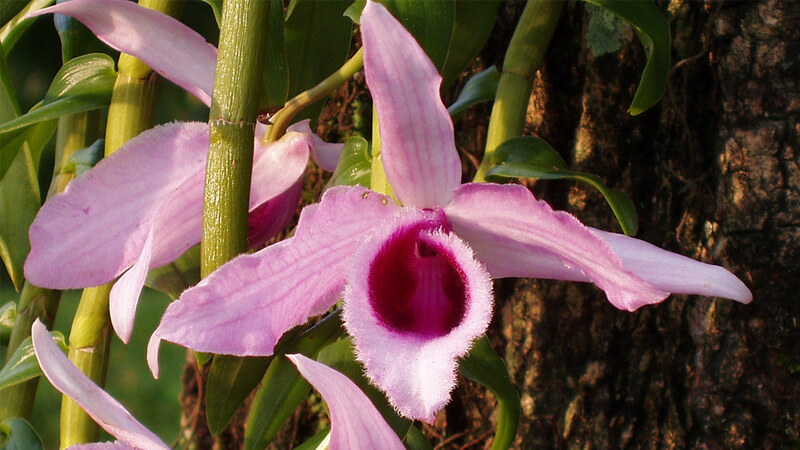 Violet Moth Orchid
Violet Moth Orchid
The Violet Moth Orchid, also known as the Giã hạc or giả hạc, is a member of the Dendrobium genus, which falls under the Orchidaceae family. It is native to Southeast Asian countries such as Thailand, Cambodia, Laos, and Vietnam.
Stem of the Violet Moth Orchid
The Violet Moth Orchid has a long stem, typically growing to a height of around 2 meters. The stem grows downward, and its thickness can vary from that of a pinky finger to a thumb in mature plants. Notably, the stem often features small purple spots in the leaf axils.
Leaves of the Violet Moth Orchid
The leaves of this orchid are succulent and grow alternately. They typically range from 7 to 12 centimeters in length and 4 to 7 centimeters in width. The shape of the leaves can vary, with some plants having rounded leaves and others having elongated leaves, depending on their growing conditions. Similar to the stem, the leaves also bear small purple spots.
As the plant prepares to flower, it sheds its leaves, and the stem turns grayish-white with black spots. With age, the stem dries out, shrinks, and takes on a brownish-purple or straw-yellow color, becoming quite shiny.
Flowers of the Violet Moth Orchid
The flowers of the Violet Moth Orchid appear at the stem’s nodes, evenly spaced. Each flower has a diameter of about 6 to 10 centimeters. They are predominantly white with a hint of purple and emit a delicate, pleasant fragrance.
2. Types of Violet Moth Orchids
There are four main types of Violet Moth Orchids: the Violet Moth Orchid, the Golden Moth Orchid, the Mutant Moth Orchid, and the Five-Petaled White Moth Orchid of Phú Thọ.
Violet Moth Orchid and Golden Moth Orchid
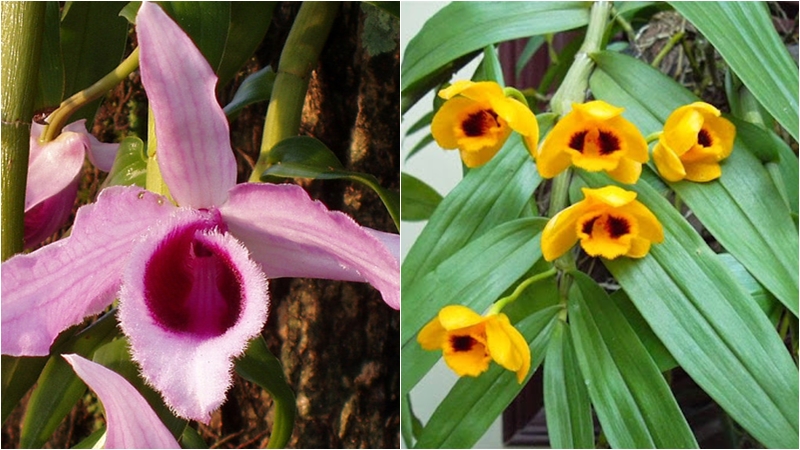 Violet Moth Orchid and Golden Moth Orchid
Violet Moth Orchid and Golden Moth Orchid
Flowering Season: The Golden Moth Orchid typically flowers from September to November, while the Violet Moth Orchid blooms after Tet, from April to August.
Color: The Golden Moth Orchid has golden-colored flowers with brown tongues and a strong fragrance. Its flowers grow in clusters. The Violet Moth Orchid, on the other hand, has white petals with a purple tint and eyes of a deeper purple shade. This variety includes types such as “eye of the deer” and “five-petaled white,” known for their captivating fragrance.
Leaves and Stem: The Golden Moth Orchid has a smaller stem compared to its violet counterpart and is green in color. The Violet Moth Orchid, true to its name, has a purple stem. The leaves of the Golden Moth Orchid are pointed and elongated, growing upward, while the Violet Moth Orchid has larger, rounded leaves that grow alternately.
Flowering Process: The Violet Moth Orchid sheds its leaves before flowering, while the Golden Moth Orchid does not require this process.
Distribution: The Golden Moth Orchid is found in the Northwest and Lâm Đồng provinces, while the Violet Moth Orchid is distributed throughout Vietnam.
Mutant Moth Orchid
 Violet Moth Orchid and Mutant Moth Orchid
Violet Moth Orchid and Mutant Moth Orchid
Distinguishing between the Mutant Moth Orchid and the typical Violet Moth Orchid is easy. The Mutant variety has eyes with alternating purple and white stripes, while the regular Violet Moth Orchid has deep purple eyes. Additionally, the Mutant Moth Orchid has white petals, in contrast to the purple petals of the standard variety.
Five-Petaled White Moth Orchid of Phú Thọ
 Five-Petaled White Moth Orchid of Phú Thọ
Five-Petaled White Moth Orchid of Phú Thọ
This variety of Violet Moth Orchid typically grows to a height of 1.6 to 2 meters, with a thick stem. The petals curve slightly inward, with the top petal pointing straight up and the side petals spreading out evenly. The flowers are white, with a heart-shaped lip adorned with snow-white velvet and two purple eyes. They emit a subtle, pleasant fragrance.
3. Cultivation and Care of the Violet Moth Orchid
Planting Techniques
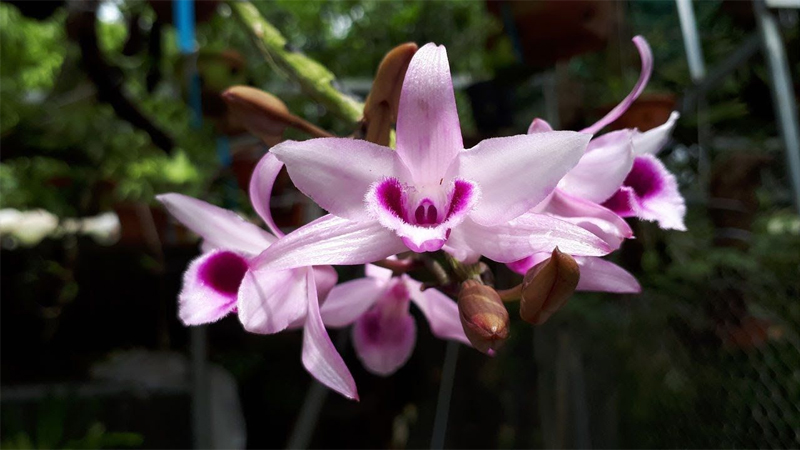 Planting Techniques for the Violet Moth Orchid
Planting Techniques for the Violet Moth Orchid
Preparation
Planting Time: The planting time depends on when you want the orchid to flower.
If you wish for spring blooms, plant from the 11th month of the lunar calendar to the 2nd month of the following year. For summer flowering, plant at the end of spring or the beginning of summer.
Planting Medium: Use a pot or container with drainage holes, such as a wooden pot or the shell of a coconut or pine tree.
Choose healthy orchid seedlings, either grown from old stems or purchased as mature plants. To ensure the best chances of survival, it is recommended to buy mature plants.
Planting Process
Gently place the seedling into the planting medium, positioning the roots carefully. Use a U-shaped piece of wire to secure the plant firmly in place. Leave it undisturbed for 5-7 days, and then water it lightly to encourage growth.
Care Techniques
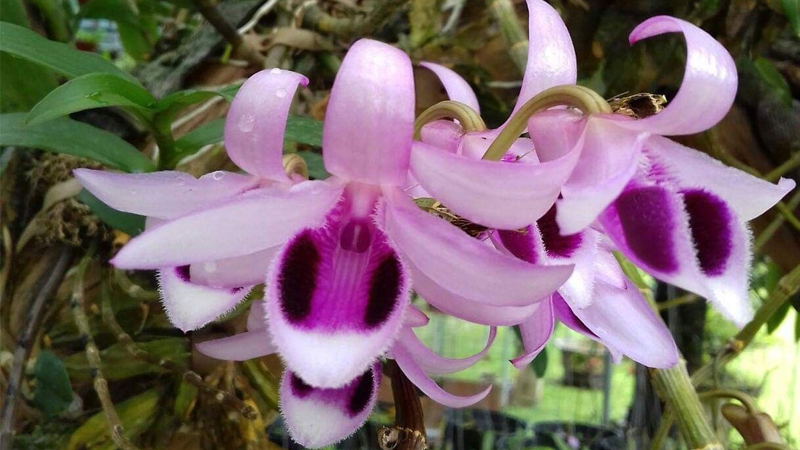 Care Techniques for the Violet Moth Orchid
Care Techniques for the Violet Moth Orchid
Watering
The Violet Moth Orchid does not require frequent watering. During the summer, water the plant 2-4 times a week, and reduce the frequency to 1-2 times a week in autumn and winter.
Light
This orchid thrives in bright, sunny conditions. You can place it outdoors, but be mindful of young leaves that may scorch in direct sunlight, so consider providing some shade with a mesh cover. If the plant appears wilted, it may be a sign that it is not receiving enough sunlight.
Temperature
The Violet Moth Orchid is remarkably resilient, tolerating temperatures as high as 38°C in summer and as low as 3.3°C in winter.
Humidity
To promote healthy growth, maintain a humidity level of 60%-70% in spring and late winter, and 80%-90% in summer and autumn.
Fertilizer
From January to September, use a 15-15-15 fertilizer. Switch to a 10-30-10 fertilizer from September to November, and then refrain from fertilizing from December to January.
Disease Prevention
To prevent diseases, spray the plant with limewater twice a month or use starner, ridomil gold, or a similar product to combat fungi that cause rot.
Propagation
Choose a healthy, robust plant with a thick stem and no signs of disease. Using a sharp knife, cut the stem into segments approximately 28-30 centimeters in length.
Soak the cuttings in a solution of 2cc b1 tonic mixed with 1 liter of water for about 20 minutes, then remove and allow them to air dry. Prepare pots or containers with drainage holes, ensuring they are disinfected. A suitable planting medium includes a mixture of wood shavings, charcoal, coconut fiber, compost, or forest moss.
Finally, attach the cuttings to the planting medium and place the pots in a bright, well-ventilated area to encourage growth.
4. Where to Buy and Price
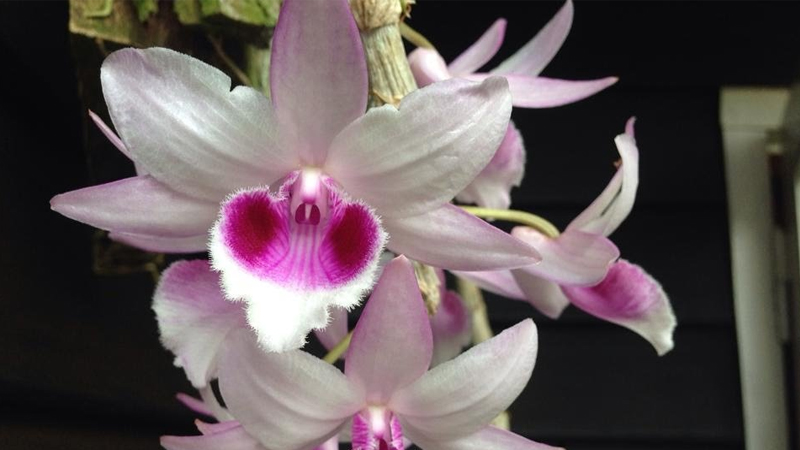 Where to Buy Violet Moth Orchids
Where to Buy Violet Moth Orchids
Reputable nurseries and garden centers across Vietnam offer Violet Moth Orchids for sale. Alternatively, you can purchase them online through e-commerce platforms such as Shopee and Lazada.
Price: 750,000 VND/plant (approximate)
We hope that this article has provided you with valuable insights into the characteristics, cultivation, and care of the Violet Moth Orchid, enabling you to grow and enjoy its beauty to the fullest.
Unlock the secret to growing beautiful, long-lasting Italian orchids indoors
The Phalaenopsis orchid is a popular and easy-to-care-for houseplant that is beloved by many. With its beautiful and vibrant blooms, it is no wonder that this orchid has become a favorite among plant enthusiasts. Once you know how to properly care for it, the Phalaenopsis orchid will reward you with frequent and stunning displays of flowers.
The Majesty of the Golden Yellow Orchid: Unveiling the Beauty and Simplicity of Growing the Phalaenopsis
The Golden Swallow Orchid is a flower of exquisite and unique beauty. Delve into the origins, symbolism, and classification of this fascinating orchid. Discover the allure of the Golden Swallow Orchid through a captivating exploration of its 8 stunning images, each a testament to its graceful elegance.






































